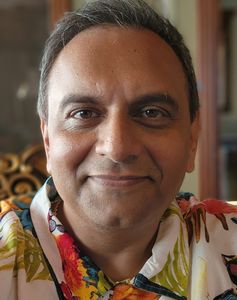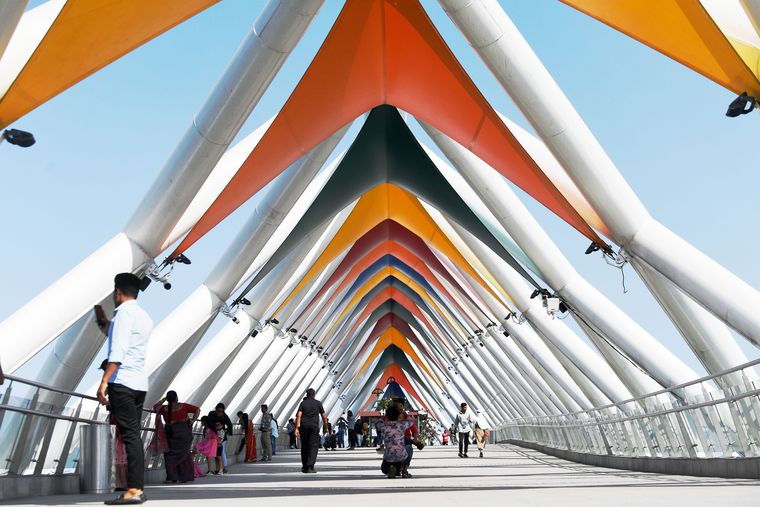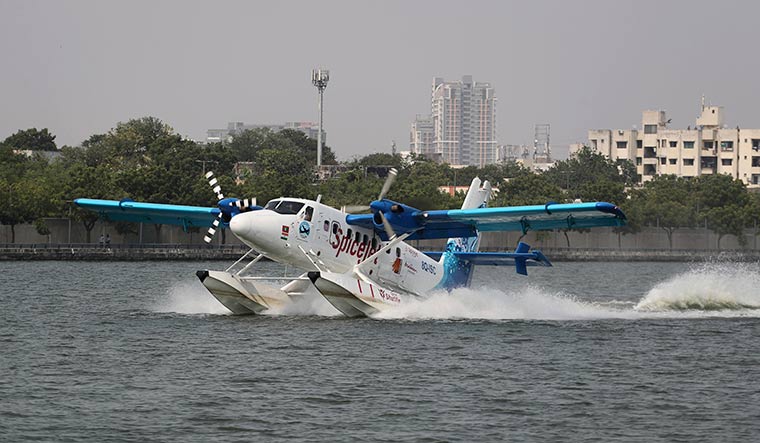Gujarat is probably the only state in the entire world that has given birth to two iconic leaders celebrated as fathers of the nation in two different countries. While Porbandar-born Mohandas Karamchand Gandhi is revered in India, Muhammad Ali Jinnah, born in Paneli―hardly 150km from Probandar―helped establish Pakistan. Sardar Vallabhbhai Patel, a proud soldier of Gandhi’s nonviolent freedom movement, led the integration of nearly 560 princely states to create modern India, and also played a key role in transforming the predominantly British civil service into India’s trusted steel frame. Suffice to say, whenever India faced a political vacuum or instability, someone from Gujarat has stepped up to meet the challenge.
Krishna, inarguably India’s most loved god and cultural icon, chose to live and die in Gujarat even as he settled the political dispute in Hastinapur. Several millennia later, Gandhi and Patel did a similar job by giving strength and direction to India’s freedom struggle. After the dark days of Emergency, Morarji Desai, another son of Gujarat, took the lead in saving the spirit of democracy. In 2014, it was the turn of Narendra Modi to offer India a stable government after decades of hung parliaments.
Gujarat showed India that an unpopular government could be brought down by a public movement when the Navnirman Andolan forced the Congress government of Chimanbhai Patel to quit in 1974. Senior BJP leader L.K. Advani chose to launch his rath yatra, which changed the face of Indian politics forever, from Somnath in Gujarat.
But more than politics, Gujarat is perhaps known for its vibrant business tradition. Home to India’s longest coastline, it has enjoyed trade ties with many nations for ages. The ancient Harappan city of Dholavira, the walled city of Ahmedabad and the ruins of the Lothal port point towards the rich business legacy of Gujaratis. No wonder they feature prominently on the list of world’s wealthiest people, headlined by prominent families like the Ambanis, Adanis, Tatas, Premjis and the Sanghvis. Family, unsurprisingly, is the key for Gujaratis, even for those settled abroad. Most Gujarati marriages are arranged affairs, often finalised taking into account caste differences. Gujaratis, in fact, consider relationships and marriages as assets and investments which should be nurtured carefully. Because of their business traits that transcend generations, Gujaratis are humble and adjustable as a community. Though the state does have a history of riots and violent protests, it is also known for the unique co-existence of various communities like the Jains, Bohras and Parsis.
While Bengal boasts a dominant literary culture and Maharashtra has a vibrant theatre scene, Gujarat has a rich tradition of both. Unfortunately, many great Gujarati creations have not been translated into other languages, although Gujaratis have welcomed translations from diverse literary traditions such as French, Arabic, English, Russian, Odiya, Tamil, Bengali and Marathi. A great literary luminary from the state is poet Narsinh Mehta, known for composing Gandhi’s favourite bhajan ‘Vaishnav Jan To Tene Kahiye’ and can be considered in the same league as Kabir, Meera or Thiruvalluvar.
Author and poet Zaverchand Meghani (1896-1947) is India’s answer to the Grimm Brothers of Germany, for singlehandedly gathering songs and folklores of Saurashtra. Meghani also translated world cinema stories and Tagore’s poems into Gujarati. K.M. Munshi was not only a leading politician, but also the author of several epic novels. He also popularised the now famous word asmita, capturing the pride and identity of Gujarat. It inspired the Mahagujarat movement by Indulal Yagnik that helped the formation of Gujarat as a state, carved out of Bombay in 1960.
Gujarati is the only regional language in India in which children’s literature modelled on the lines of what Walt Disney and Roald Dahl created in the west found multiple practitioners like Jivram Joshi, Ramanlal Soni and Hariprasad Vyas. Well-known humorists like Jyotindra Dave, Tarak Mehta, Vinod Bhatt, Bakul Tripathi and Shahabuddin Rathod were unique satirists who thrived in Gujarat. The state is blessed with a pantheon of literary masters like Chandrakant Bakshi, Suresh Joshi, Ashwini Bhatt, Harkisan Mehta, Vitthal Pandya, Madhu Rye, Mohammad Mankad, Ramesh Parekh, Mareez, Sitanshu Yashaschandra, Sundaram, Dhumketu, Chunilal Madia, Niranjan Bhagat, Manubhai Pancholi, Dhruv Bhatt, Kundanika Kapadiya, Gunvantrai Acharya and Dula Bhaya Kag. While the first Indian novel in English was written by Bankim Chandra Chatterjee in 1864, the first Gujarati novel was published just two years later.
Gujaratis have many such stories to tell, even beyond literature. While the first original Indian newspaper Samvad Kaumudi was published in Bengali in 1821, the first Gujarati newspaper Mumbai Samachar followed in 1822. It remains the oldest continuously published newspaper in India. Gujaratis prefer their own newspapers and some of them have crossed millions in circulation. Rajkot alone has more than half a dozen evening dailies. Gujaratis love the ‘magazine’ sections in their newspapers and some of them are featured daily. Many of the newspaper columnists enjoy a huge fan following. Gujaratis also have the habit of organising regular community lecture programmes and pay hefty amounts to guest speakers. Osho, in fact, started his discourse in Gujarat.
Faith and spirituality have been close to Gujarat’s heart. Local sages like Jalaram Bapa, Sant Devidas, Aapa Giga, Dada Mekan, Dasi Jeevan, Bhoja Bhagat, Gangasati, Santram Maharaj, Shri Mota, Anandabava, Ranchoddasji Bapu, Haricharandasji, Bajrangdas Bapa and Nathabhai Joshi have done impeccable community service. The state is home to the globally recognised Swaminarayan sect, known for its magnificent temples.
Gujarat is home to globally renowned artists like Bhupen Khakhar, Atul Dodiya, Tayyab Mehta, Jeram Patel, Haku Shah, Gulam Mohammad Sheikh, Vrundavan Solanki, Balkrishna Doshi, Kumudini Lakhia and Mrinalini Sarabhai. The largest collection of M.F. Husain’s paintings is preserved by Anil Relia in Ahmedabad. Maharaja Sayajirao of Baroda was a key benefactor of Raja Ravi Varma and Dadasaheb Phalke.
Renowned physicist Vikram Sarabhai, the visionary behind various centres of excellence like the PRL (Physical Research Laboratory), IIM Ahmedabad, ATIRA (Ahmedabad’s Textile Industry’s Research Association) and ISRO, hails from Gujarat. At the other end of the spectrum is the legendary Ela Bhat, who founded SEWA (Self-Employed Women’s Association) to ensure that the rights of women workers from the unorganised sector are protected.
Also read
- Gujarat: Modi mantra of good governance infused with hindutva pays rich dividends
- Modi magic dispels all obstacles to win Gujarat in style
- What led to Congress's decimation in Gujarat
- What can Congress learn from Gujarat loss and Himachal win
- In its local and state level endeavours, AAP aims to achieve its national ambition
- Himachal: 10 guarantees Congress gave to the voter that helped it win
Although the first Gujarati film was made in 1932, Gujaratis have contributed immensely to the Hindi film industry even before that. Stalwarts like Mehboob Khan, Chandulal Shah, Manmohan Desai, Sanjay Leela Bhansali, Sanjeev Kumar, Paresh Rawal, Kalyanji Anandji, Himesh Reshammiya, Anees Bazmi, Abbas Mustan, Sachin Jigar, Amit Trivedi, Mukesh, Pankaj Udhas, the Bhatt family and the Irani family are among those who helped shape the Hindi film industry. The Gujarati industry, meanwhile, has come a long way with the film Chhello Show by Pan Nalin getting nominated as the Indian entry for the Oscars. Cricket, too, has a passionate following in Gujarat, home to superstars like Ranjitsinhji, Vinoo Mankad, Ravindra Jadeja and Hardik Pandya among others.
Although Gujarat was an international trading hub and was ruled by Islamic rulers and the British for centuries, its sociocultural ethos remained largely unaffected, compared with other regions of India. One does not witness in Gujarat the Islamic influence in food, architecture, design, clothing and language to the extent one sees in Delhi or Lucknow. To hold on to their cultural identity, despite sustained external influences, has been a Gujarati characteristic for a very long time. While it can be interpreted as conserving its identity or resistance to change, it shows how Gujarat has always remained rooted to its rich history and traditions.
More than 700 varieties of tasty vegetarian dishes are regularly made in Gujarati homes. All 33 districts of Gujarat have distinct variety of food to offer, unlike the chemically uniform western food. It was Virji Vora, a Gujarati trader who was among the richest men in the world in the 17th century, who popularised tea among the British. Amul and other dairy cooperatives in the state started India’s White Revolution, popularising milk and milk products. Same goes in the textile sector, where Gujarat is ahead in cotton production and its khadi is also well-known.
With its 1,600km long coastline and abundant wasteland in the form of the Great Rann of Kutch, Gujarat has taken the lead in mitigating the effects of climate change. The state started a dedicated department to oversee its mission as early as in 2009. Considering its ideal geographical location, Gujarat was first off the blocks to implement renewable energy through policy interventions. As a result, the state has achieved 19,000MW of installed capacity by 2022. It has the distinction of being the first in the world to install canal-top solar plant and has the maximum number of solar rooftop installations in India. The state is developing the world’s largest single location wind–solar renewable energy park of 30GW capacity in Kutch. Gujarat has great potential for off-shore wind energy as well. As India has committed to achieve net-zero emissions by 2070, Gujarat is at the forefront of transforming its energy mix with greater reliance on renewable energy.
Despite the achievements made in diverse fields, the portrayal of Gujarat and Gujaratis often borders on infantile caricaturisation like the ‘Jigneshbhai’/ ‘Dayaben’ types. Gujarat, however, is much beyond that. Women find it safe to walk around Gujarat’s cities late in the night, unlike in most other parts of India. And as Modi reminds everyone, the Navratri festival which lasts for nine days is the “longest-running song and dance festival on earth”. The raas garba is a global identity marker for Gujarat. Barring Punjab’s bhangra, no other Indian traditional folk dance has such universal appeal.
Despite the obvious advantages, the Gujarati youth have many more milestones to aspire for. The urban youth are giving up reading and writing in their local language and are dropping out of Gujarati medium schools. The rural youth, meanwhile, are still in the grip of rigid traditions, despite adopting digital technology. Many of them may wear modern outfits and use the latest mobile phones, but they are confused about accepting the modern, scientific approach. They watch the latest dramas on OTT platforms, listen to K-pop and make Instagram reels. But love marriages are still taboo and casteism remains strong. Most of them lack the dynamism to communicate beyond their comfort zones and they often shy away from challenging tasks.
Still, Gujaratis enjoy having fun. They celebrate almost all festivals. From Janmashtami to Eid, Makar Sankranti to Christmas and Diwali to Moharram, there is no festival that they would miss. They just need an excuse for gathering and travelling with family and friends. And that is the spirit of Gujarat. Their genes have made Gujaratis adventurous and adjustable at the same time. They are global and local, with a colourful culture that conquers the world with a smile, and not sword. A close look at the map will show that Gujarat looks like the right hand of India. On our currency notes, we have the face of a smiling Gujarati, welcoming all and loving all. Gujarati poet Umashankar Joshi rightly captures the spirit of being Gujarati: “E te kevo Gujarati, je hoy keval Gujarati (one is not a true Gujarati if he remains just a deep-rooted Gujarati. One should make connections and be a global human being).”
Vasavada is a writer, motivational speaker and columnist.





